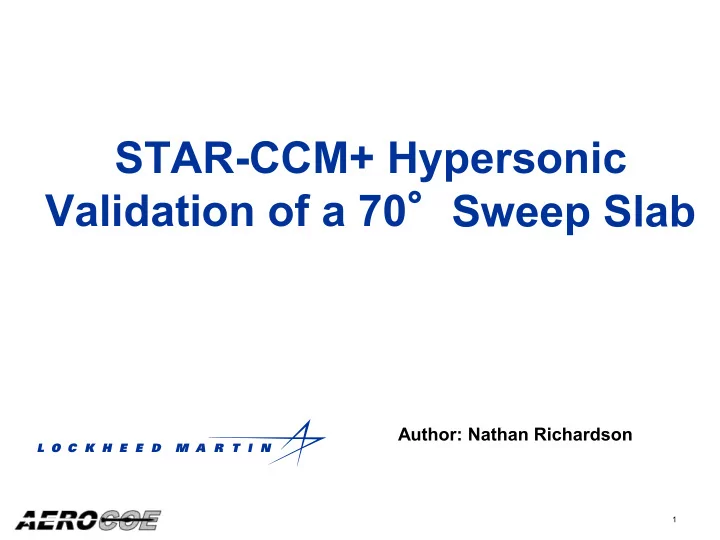

STAR-CCM+ Hypersonic Validation of a 70 ° Sweep Slab Author: Nathan Richardson 1
Purpose • Desired to do validation runs of STAR-CCM+ to wind tunnel for Hypersonic flow – Wind Tunnel data from NASA Report R-153 • Comparison of 70 ° Sweep Slab Delta Wing in Hypersonic flow to analytical methods • Mach 6.8, and 9.6 flows from -2.5 ° - 45 ° angles of attack • Other Conditions tested but are not compared here • Desired to attempt a flow adaptive grid refinement 2
Geometry • Geometry was created in the STAR-CCM+ CAD package. • Created two geometries, a sharp and blunted versio: – Sharp geometry has cylindrical leading edges coming to a point in the front. – Blunt geometry has cylindrical leading edges with a hemispherical nose. • Added pressure monitors to both geometries similar to wind tunnel test (with 0.001” offset from surface). • No information on the sting was in the report, so no attempt to replicate that was made. 3
Meshing • Created an initial Mesh of each of the bodies – ~360k Polyhedral Cells – 5 Prism Layers, 0.025” thick • Intent was for a very coarse mesh as a starting point • Remeshed based on CFD solution 4
Grid Refinement Field Function • Created a series of field functions to adapt the existing mesh. – Cell_Size Current cell size • Pow($Volume,1/3) • – Mach_Gradient Gradient of the Mach number • Grad($MachNumber) • – Max_Cell_Rescaler Sets a limit to prevent the cell size from changing too much • • ($$Position.mag()>0.8)? 1.1: ($$Position.mag()>0.7) ? 2 : ($$Position.mag()-0.7)/0.1 + 1.1) – Desired_Cell_Size Cell Size used for remeshing to achieve <0.05 Mach variation across cell. Capped to prevent cell size • increase and prevent size reducing too much • Max(max(min(1/($$Mach_Gradient.mag()+0.0000001*0.05, $Cell_Size), $Cell_Size/$Max_Cell_Rescaler), 0.00015) – Cell_Scaler Determine ratio of desired cell size to actual (Diagnostic Only) • • $Desired_Cell_size/$Cell_Size 5
Solving Strategy Sharp Body; Mach 6.8; AoA 0 Initial Remesh 1 Remesh 2 • Ran to converged solution on initial mesh • Refine – Lower surface mesh targets and minimums Sharp Body; Mach 9.6; AoA 45 – Set Desired_Cell_Size to Initial Remesh 1 Remesh 2 an XYZ_Table, than assign the XYZ table as the mesh size table • Iterate to a converged solution • Refine Blunt Body; Mach 6.8; AoA 20 – Set Desired_Cell_Size to Initial Remesh 1 Remesh 2 an XYZ_Table, than assign the XYZ table as the mesh size table • Iterate to final converged solution 6
Shock Capture • Refinement captures Shocks well Mach Number Absolute Pressure 7
Physics Models • Physics Models – All y+ Wall Treatment – Coupled Energy – Coupled Flow • AUSM+ FVS – Gas • Air – Specific heat to Polynomial in T – Ideal Gas – Steady – Three Dimensional – Reynolds Averaged Navier Stokes – Turbulent – K-Omega Turbulence – SST (Menter) K-Omega 8
Conditions Tested • Ran a Angle of Attack sweep from -2.5 ° – 45 ° for each case. Conditions Mach 6.80 9.60 (-) Pstat 18.43 2.94 (PSF) Tstat 108.28 85.41 ( R ) Reynolds # 258000 87000 (-) 9
Results: Blunt Body Centerline Pressure Comparisons • Pressure normalized by stagnation pressure after shock • Good qualitative agreement, good quantitative agreement for lower angles of attack Red = Mach 6.8 Unfilled = Mach 6.8 Blue = Mach 9.6 Filled = Mach 9.6 10
Results: Blunt Body; Mach 6.8 Lift Comparisons • CFD slightly over-predicts peak L/D • Matches CL well at lower angles of attack, with more error at higher angles 11
Results:Blunt Body; Mach 9.6 Lift Comparisons • CFD slightly over-predicts peak L/D • Matches CL well at lower angles of attack, higher angle of attack not collected in tunnel due due to shock on tunnel boundary layer interaction 12
Results: Sharp Body; Mach 6.8 Lift Comparisons • CFD slightly over-predicts peak L/D • Matches CL well at lower angles of attack, with more error at higher angles 13
Results: Sharp Body; Mach 9.6 Lift Comparisons • CFD slightly over-predicts peak L/D • Matches CL well at lower angles of attack, with more error at higher angles 14
Results: Blunt Body; Mach 6.8 Drag Comparisons • CFD did not capture pitching moment trend at high Angle of Attack • Matches CD well at lower angles of attack, with more error at higher angles 15
Results: Blunt Body; Mach 9.6 Drag Comparisons • Pitching Moment near zero for all tested conditions • Matches CD well at lower angles of attack, higher angle of attack not collected in tunnel due to shock on tunnel boundary layer interaction 16
Results: Sharp Body; Mach 6.8 Drag Comparisons • CFD did not capture pitching moment trend at high Angle of Attack • Matches CD well at lower angles of attack, with more error at higher angles 17
Results: Sharp Body; Mach 9.6 Drag Comparisons • Pitching Moment near zero for all tested conditions • Matches CD well at lower angles of attack, higher angle of attack not collected in tunnel due to shock on tunnel boundary layer interaction 18
Future Improvements • Future work would attempt to improve on the current work – Add transition model – Further mesh refinement – An expanded polynomial for specific heat • Also could explore more real world representative cases – More complicated geometry – Higher total temperature case 19
Conclusions • STAR-CCM+ was able to replicate the behavior of the wind tunnel test for angles of attack below 30 ° well – Peak L/D was a little high – Overall a good match • At angles of attack above 30 ° the validation was not as good – Lift and Drag were both overpredicted – Pitching moment behavior did not match well – L/D was still a good match • Several sources for differences – No sting in CFD, and no reference to how sting effects were addressed in the report – Measurement error / tunnel effects – CFD error 20
21
Recommend
More recommend